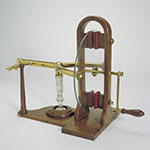This plate frictional electrical machine is similar to, but smaller than, item inv. 2705. One of a set of four machines used to demonstrate the effects of different materials on the polarity of the generated charge, positive or negative. According to the 1776 catalogue of the Museo di Fisica e Storia Naturale, the substances used were: glass, glass coated with red sealing wax, rough glass (inv. 2687), and glass covered with black velvet (inv. 2686). At a later stage, one of the machines (inv. 2689) had its disk replaced by one of bismuth. The brass prime conductor, supported by a glass pillar, has two curved arms, each ending in a concave disk with sharp points (the collectors), which end in close proximity to the surface of the glass disk. The amount of charge is controlled by the Lane discharging electrometer with vernier scale on its wooden support. Nearly all the machines of this type seen in European collections are English-made, usually from London. Provenance: Lorraine collections.










